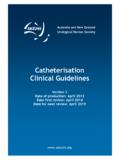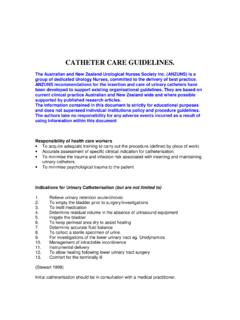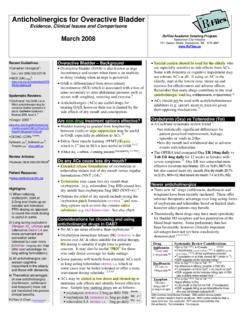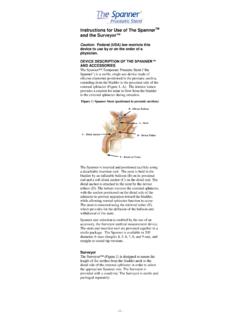Transcription of Index [www.anzuns.org]
1 APRIL 2013 CATHETERISATION CLINICAL GUIDELINES Clinical Guidelines | Edited by Trish White, Lynn Brinson and Julia Glentworth Index Page Introduction 3 Professional Requirements for Nurses 4 Indications for Catheterisation 5 Urethral 5 Suprapubic 6 Intermittent 6 Term of Catheterisation 8 Intermittent 8 Short term 8 Long term 9 Potential Complications and Contraindications 10 Urethral 10 Suprapubic 10 Intermittent Self Catheterisation 11 Catheter Selection and Products 13 Type 13 Materials 14 Size 16 Length 17 Balloon Size 17 Drainage Systems 18 Bag Selection 18 Disposable two litre bags (night bags) 18 Disposable two litre closed system bag (hourly measure) 18 Disposable leg bags (day bags) 19 Clinical Guideline Catheterisation 2. Disposable four litre bags 20 Catheter valves 20 Catheter Securement 20 Catheter Storage 21 Procedure Guidelines 22 Male Urethral Catheterisation 22 Female Urethral Catheterisation 24 Suprapubic Catheterisation 26 Intermittent Self Catheterisation (ISC) 28 Female ISC 29 Male ISC 30 Neobladder / Stoma ISC 31 Catheter Management 32 Bladder Instillations 32 Please refer to the ANZUNS Clinical Guideline Instillation of Intravesical Solutions [1] Principles of Catheter Associated urinary Tract Infection (CAUTI) 32 Assessing the Need for Catheterisation 32 Selection of Appropriate Catheter Type and Drainage System 32 Catheter Insertion 33 Catheter Maintenance 34 Documentation 35 Abbreviation list 35 References 36 Clinical Guideline Catheterisation 3.
2 Introduction Clinical guidelines for catheterisation have been in draft format and regularly reviewed since 2001. The Australia and New Zealand Urological Nurses Society Inc (ANZUNS) project officer has now developed these guidelines into formal Clinical Practice Guidelines. Trish White, Lynn Brinson and Julia Glentworth have edited this edition, and our thanks also go to the following who kindly volunteered to peer review the document: Audrey Burgin Clinical Project Officer Continence, HACC/MASS Continence Project Queensland, Australia Jean Bothwell Urology Nurse Specialist Waitemata District Health Board, New Zealand Vivienne Dyer Specialty Clinical Nurse Urology Surgical Outpatients, Nelson Marlborough District Health Board, New Zealand Lynda Hardy Clinical Nurse Consultant, Box Hill Hospital Practice Nurse, Australian Urology Associates Pty Ltd, Melbourne, Australia Barbara McPherson Infection Control Advisor Quality and Risk Service, Hawke's Bay District Health Board, New Zealand Kay Talbot Practice Nurse/Manager Australian Urology Associates Pty Ltd, Melbourne, Australia The guidelines have been produced to assist appropriately trained Health Care Professionals in the safe management of urinary catheters in adults.
3 They can be used as a guide to practice but are not definitive and local policy must be followed. Recommended evidence based best practice has been utilised as a basis for this guideline. Acknowledgment to Wayne Blair, Clinical Photographer, HBDHB, New Zealand, for allowing the use of his photographs. The following are acknowledged for their contribution to developing the initial draft document prior to the appointment of the AUZNUNS project officer. Draft 1 Trish White and Cheryl Hennah 2001 Draft 2 Nicola Walker and Kay Talbot 2003 Draft 3 Nicola Walker and Kay Talbot 2004 Draft 4 Kay Talbot and Nicola Walker 2005 Version 1 Kay Talbot and AUNS Catheter Care SIG 2006 Version 2 Trish White, Lynn Brinson, Julia Glentworth 2013 Clinical Guideline Catheterisation 4. Professional Requirements for Nurses Only those Health Care Professionals who are trained and have a clear knowledge and understanding of the urinary tract, the catheterisation process and the principles of asepsis should be permitted to insert urethral and change suprapubic catheters.
4 A competency based training programme containing the theoretical component of catheterisation training followed by a period of supervision until the nurse is competent in the technique of catheterisation is recommended [2, 3]. Ongoing refresher courses to review techniques, complications and new products should be available to all staff who catheterise. Community and primary healthcare workers must be trained in catheterisation as above [2]. ANZUNS recommends the initial order to insert a catheter must be from a suitably qualified Medical Practitioner, Nurse Practitioner, Advanced Practice Nurse, experienced urological Registered Nurses practicing within their scope of practice and according to local guidelines. ANZUNS recommends only Nurse Practitioners, Registered Nurses and Enrolled Nurses (who are under delegation and supervision of a Registered Nurse) are permitted to insert urethral and change suprapubic catheters.
5 Advanced Practice Nurses can do initial insertion of a suprapubic catheter if this falls within their scope of practice. An experienced Urology Nurse should do the first suprapubic catheter change. Thereafter a competent Health Care Professional. Clinical Guideline Catheterisation 5. Indications for Catheterisation Urethral: Insertion of a catheter into the urinary bladder via the urethra [4]. The indications are: To relieve acute urinary retention or bladder outlet obstruction [5 13] Close monitoring of urine output in acute renal failure and in the critically ill patient [5 9, 12]. Peri operative use for selected surgical procedures patients undergoing urologic surgery or to other adjoining structures of the genitourinary tract [5 9] Anticipated prolonged duration of surgery or patients anticipated to receive large volume infusions or diuretics during surgery [7] To enable pre and post operative bladder drainage Trans urethral resection of prostate (TURP) [7 9, 14] To facilitate irrigation of the bladder and management of haematuria/clot retention [7] Potential for use during labour and delivery or surgery when an epidural has been utilised The need for intra operative monitoring during surgery [7] Chronic urinary retention in the symptomatic patient ( renal impairment or urinary tract infection) when intermittent self catheterisation (ISC)
6 Is not an option and retention cannot be corrected medically or surgically [7] To facilitate urodynamic studies or specialist radiological procedures Instillation of cytotoxic drugs directly into the bladder [7] To measure residual urine after patient has voided in the absence of a bladder scanner [7] In patients with neurological disorders causing paralysis or loss of sensation leading to voiding difficulties [6, 12] Patients requiring prolonged immobilization multiple traumatic injuries such as pelvic fractures [6, 9] Where a patient insists on this form of management after discussion and understands the risks [15] To manage intractable incontinence as a last resort or when incontinence poses a risk of infection of nearby surgical sites or skin breakdown [8, 10, 15] Management of impaired skin integrity and to assist healing of open sacral or perineal wounds [6 8, 12] To improve comfort for end of life care [5 9, 12] Clinical Guideline Catheterisation 6.
7 Suprapubic: Insertion of a catheter into the bladder via the anterior abdominal wall [4]. The indications are: Acute or chronic urinary retention following unsuccessful attempts at urethral catheterisation [7, 8, 16 19] Unable or unwilling to perform intermittent self catheterisation [20 22] Patient preference wheel chair bound, sexual function related issues [7, 8, 22, 23] Long term bladder drainage for patients with neurological disease [18, 23] Anatomical problems in the urethra stricture, obstruction, trauma [7] Mobility issues [7, 8, 24] Complications of long term urethral catheterisation egg penile meatal ulcer or catheter induced urethritis [7, 24] When urethral or pelvic floor trauma is suspected [25] Post operatively following complex urethral, genitourinary or abdominal surgery [7] To decrease risk of contamination with organisms from faecal material [7, 23, 24, 26] Acute prostatitis [7, 16] Patient comfort [7, 23, 24] Intermittent Self Catheterisation (ISC).
8 Inserting a catheter into the bladder via the urethra or other catheterisable channel such as Mitrofanoff continent urinary diversion to drain urine. The catheter is removed immediately after emptying the bladder. [27]. ISC is considered the gold standard of urine drainage for bladder emptying dysfunction [6, 7, 21, 22, 28, 29]. The indications are: ISC assists in protecting renal function, decreases incontinence, limits urinary tract infections (UTI), improves lower urinary tract symptom control and enhances quality of life [29, 30] Poorly emptying bladder >150mL, atonic bladder, detrusor underactivity or detrusor sphincter dyssynergia or associated with aging [20, 22, 27, 29] Bladder outlet obstruction, benign prostatic hyperplasia (BPH) [28 30] Clinical Guideline Catheterisation 7. To catheterise continent urinary diversions [27] Post surgical procedures some surgery for stress urinary incontinence [20, 22, 30] Neurogenic bladder dysfunction including multiple sclerosis, Parkinson's, effects of diabetes, cerebral vascular accident, spina bifida, spinal injuries, post epidural/spinal anaesthetic, pudendal nerve damage post childbirth [22, 27, 30] To dilate urethral strictures using intermittent dilatation [6, 21, 29 31] ISC also reduces interference in sexual activity and decreases need for equipment and appliances [6, 22, 29, 32] In the hospital setting intermittent catheterisation is a sterile procedure performed by health professionals and can be used to.
9 O relieve acute urinary retention o obtain a clean urine specimen o measure post void residual o instill medication into the bladder BCG, anticholinergics [4, 7, 21, 23] Clinical Guideline Catheterisation 8. Term of Catheterisation Any urinary catheter should be left in situ for the minimum possible time. Catheterisation is divided into three groups, intermittent, short term and long term [4, 31, 33 36]. Intermittent Self Catheterisation Frequency of catheterisation can vary [22] and urine frequency, post void residual and bladder capacity should be assessed to establish frequency. ISC should be performed at regular intervals to prevent bladder distention and in general the total volume should not exceed 400 500mL. Urine volume therefore should determine catheterisation schedule and unnecessary catheterisation should be avoided to decrease the Catheter associated urinary tract infection CAUTI risk.
10 [21, 30] For example if the patient is unable to void they may have to catheterise up to six times a day, or if bladder volume >500mL per void, aim for at least three times a day, if <100mL residual volume for three consecutive times stop catheterising [22, 30]. The changing nature of disease process may mean changes in management should be regularly considered [20]. Short Term Catheterisation There is no agreement on the classification of short term indwelling catheterisation with it varying between 8 29 days and as per manufacturer instructions. For the purposes of this document we have defined it as 28 days [24]. Therefore a short term catheterisation is defined as the catheter being in situ 28 days or less [24]. Use Latex based, silicone elastomer coated catheter as first choice for short term catheter (unless patient has latex sensitivity) [36]. Silver alloy or antibiotic coated catheters may be considered for short term use.









